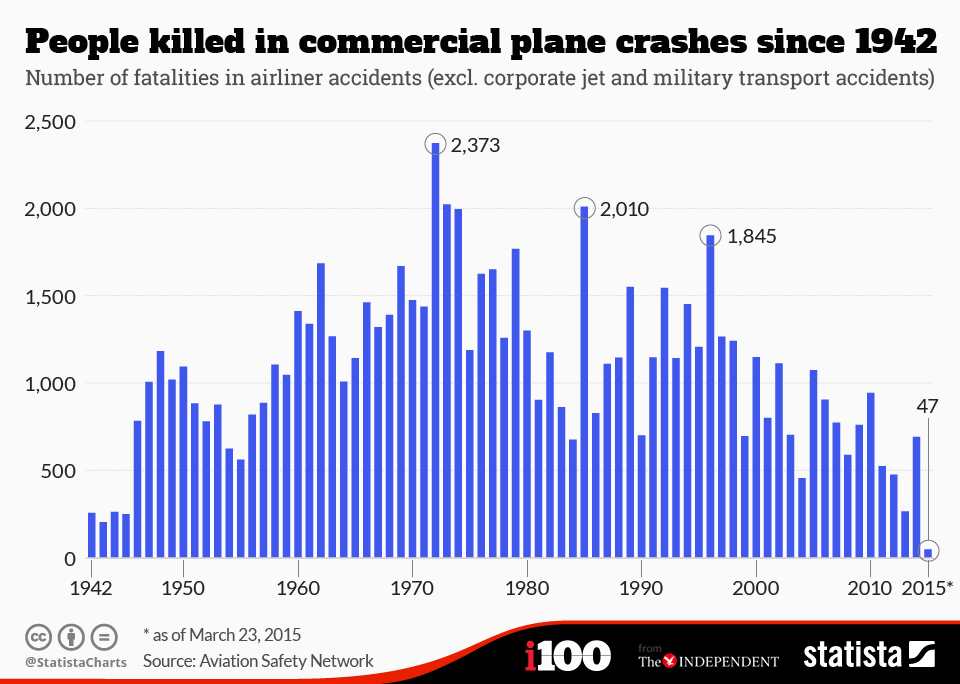Near Misses And Crashes: A Visual Look At Airplane Safety Data

Table of Contents
The Rarity of Major Air Crashes
Despite media attention often focusing on individual air crash incidents, major air crashes are statistically rare. This fact, however, shouldn't diminish the importance of continuous safety improvements. Illustrating this with data visualization is crucial to properly contextualize the risk.
- Global air crash rates have decreased significantly over the past few decades. Graphs showing accident rates per billion passenger kilometers flown dramatically illustrate this downward trend, emphasizing the success of safety initiatives. The data clearly showcases a continuous improvement in aviation safety.
- Technological advancements and stringent safety regulations have played a crucial role. The implementation of advanced flight data recorders, improved pilot training programs, and stricter maintenance standards have all contributed to a safer aviation environment. These factors, combined with rigorous accident investigation processes, are key to understanding and preventing future accidents.
- Data visualization helps contextualize the rarity of major accidents within the vast number of flights. Visual representations, such as charts comparing the number of flights to the number of accidents, put the statistically low probability of a major air crash into perspective. This visual context is essential for dispelling public misconceptions and promoting confidence in air travel.
Understanding Near Misses in Aviation
Near misses, while not resulting in crashes, are significant aviation safety incidents. These events represent potential safety hazards that, if not thoroughly analyzed, could lead to future accidents. Analyzing the frequency and types of near misses is therefore crucial.
- Near misses often involve human error, weather conditions, or technical malfunctions. Runway incursions, for instance, often involve a combination of factors like poor communication and adverse weather. Visualizing these near misses on airport maps can highlight potential trouble spots and areas needing improved safety protocols.
- Investigating near misses is critical for identifying potential risks and improving safety protocols. By examining near misses, aviation authorities can proactively address latent safety issues before they result in a major accident. This proactive approach, guided by the data, is essential to continuous safety improvement.
- Visual representations (maps, charts) can illustrate the locations and types of near misses. Heatmaps, for example, can pinpoint geographical areas with a higher frequency of near misses, allowing for targeted improvements in safety procedures or infrastructure. This allows for a clearer visualization of the types of incidents and helps in implementing better safety measures.
Data Visualization: Unveiling Patterns and Trends
Effective data visualization is paramount for understanding complex aviation safety data. By using charts, graphs, and maps, we can identify patterns, trends, and areas needing improvement.
- Heatmaps can show geographical concentrations of incidents. This allows for the identification of airports or flight paths with higher-than-average incident rates. This spatial visualization allows for targeted resource allocation for improvements.
- Line graphs can illustrate trends in accident rates over time. These graphs show whether safety initiatives are effective, highlighting successes and areas that require further attention. Clear visual trends allow for better data-driven decision-making.
- Bar charts can compare the frequency of different types of incidents. This allows for a clear comparison between, for example, human error, mechanical failure, and weather-related incidents. This visualization helps prioritize areas for safety improvements.
The Role of Technology in Enhancing Airplane Safety
Technological advancements play a vital role in enhancing airplane safety, contributing significantly to the decrease in air crash statistics and near misses.
- Automatic Dependent Surveillance-Broadcast (ADS-B) enhances situational awareness. This system provides real-time aircraft position data, improving air traffic control efficiency and reducing the risk of collisions. The visualization of this data aids air traffic controllers in managing traffic flows effectively.
- Ground Proximity Warning Systems (GPWS) provide crucial alerts to pilots. These systems alert pilots of potential ground collisions, significantly reducing the risk of Controlled Flight into Terrain (CFIT) accidents. This technological safeguard directly improves flight safety.
- Advanced flight data recorders provide valuable insights into accident investigations. These "black boxes" capture vast amounts of flight data, assisting investigators in determining the causes of accidents and informing future safety improvements. The detailed data these recorders provide are vital in preventing future incidents.
Conclusion
This visual exploration of airplane safety data reveals the remarkable safety record of air travel, while emphasizing the importance of continuous vigilance. Near misses and crashes, though statistically rare, offer invaluable lessons for improving aviation safety. Data visualization plays a critical role in identifying trends, understanding contributing factors, and implementing effective safety measures. Analyzing air crash statistics and near-miss incidents through visual data empowers us to work towards an even safer future for air travel.
Call to Action: Stay informed about airplane safety advancements and support initiatives that promote safer air travel. Learn more about aviation safety data and near misses by exploring reputable sources and staying updated on the latest research. Understanding the data behind airplane safety contributes to a safer future for all air travelers. Let's continue to improve flight safety and reduce both near misses and crashes through data-driven analysis and technological advancements.

Featured Posts
-
 Evrovidenie Pobediteli Poslednikh 10 Let I Ikh Sudba Segodnya
May 24, 2025
Evrovidenie Pobediteli Poslednikh 10 Let I Ikh Sudba Segodnya
May 24, 2025 -
 Analyse Krijgt De Snelle Marktdraai Van Europese Aandelen Ten Opzichte Van Wall Street Een Vervolg
May 24, 2025
Analyse Krijgt De Snelle Marktdraai Van Europese Aandelen Ten Opzichte Van Wall Street Een Vervolg
May 24, 2025 -
 Country Escapes A Comprehensive Guide To Rural Living
May 24, 2025
Country Escapes A Comprehensive Guide To Rural Living
May 24, 2025 -
 Joy Crookes Carmen Song Review And Analysis
May 24, 2025
Joy Crookes Carmen Song Review And Analysis
May 24, 2025 -
 Prime Videos Picture This A Guide To The Complete Soundtrack
May 24, 2025
Prime Videos Picture This A Guide To The Complete Soundtrack
May 24, 2025
Latest Posts
-
 Kazakhstanskiy Triumf Tretiy Vykhod V Final Kubka Billi Dzhin King
May 24, 2025
Kazakhstanskiy Triumf Tretiy Vykhod V Final Kubka Billi Dzhin King
May 24, 2025 -
 Pobeda Aleksandrovoy Otchet O Matche Protiv Samsonovoy V Shtutgarte
May 24, 2025
Pobeda Aleksandrovoy Otchet O Matche Protiv Samsonovoy V Shtutgarte
May 24, 2025 -
 Aleksandrova Samsonova Itogi Pervogo Kruga Turnira V Shtutgarte
May 24, 2025
Aleksandrova Samsonova Itogi Pervogo Kruga Turnira V Shtutgarte
May 24, 2025 -
 Shtutgart Aleksandrova Obygrala Samsonovu V Pervom Kruge
May 24, 2025
Shtutgart Aleksandrova Obygrala Samsonovu V Pervom Kruge
May 24, 2025 -
 Samsonova Ustupaet Aleksandrovoy V Pervom Kruge Shtutgartskogo Tennisnogo Turnira
May 24, 2025
Samsonova Ustupaet Aleksandrovoy V Pervom Kruge Shtutgartskogo Tennisnogo Turnira
May 24, 2025
